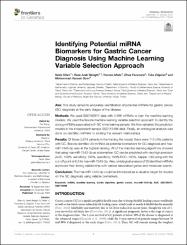Identifying Potential miRNA Biomarkers for Gastric Cancer Diagnosis Using Machine Learning Variable Selection Approach
Citation
Gilani N, Arabi Belaghi R, Aftabi Y, Faramarzi E, Edgünlü T and Somi MH (2022) Identifying Potential miRNA Biomarkers for Gastric Cancer Diagnosis Using Machine Learning Variable Selection Approach. Front. Genet. 12:779455. doi: 10.3389/fgene.2021.779455Abstract
Aim: This study aimed to accurately identification of potential miRNAs for gastric cancer (GC) diagnosis at the early stages of the disease. Methods: We used GSE106817 data with 2,566 miRNAs to train the machine learning models. We used the Boruta machine learning variable selection approach to identify the strong miRNAs associated with GC in the training sample. We then validated the prediction models in the independent sample GSE113486 data. Finally, an ontological analysis was done on identified miRNAs to eliciting the relevant relationships. Results: Of those 2,874 patients in the training the model, there were 115 (4%) patients with GC. Boruta identified 30 miRNAs as potential biomarkers for GC diagnosis and hsa-miR-1343-3p was at the highest ranking. All of the machine learning algorithms showed that using hsa-miR-1343-3p as a biomarker, GC can be predicted with very high precision (AUC; 100%, sensitivity; 100%, specificity; 100% ROC; 100%, Kappa; 100) using with the cut-off point of 8.2 for hsa-miR-1343-3p. Also, ontological analysis of 30 identified miRNAs approved their strong relationship with cancer associated genes and molecular events. Conclusion: The hsa-miR-1343-3p could be introduced as a valuable target for studies on the GC diagnosis using reliable biomarkers.


















